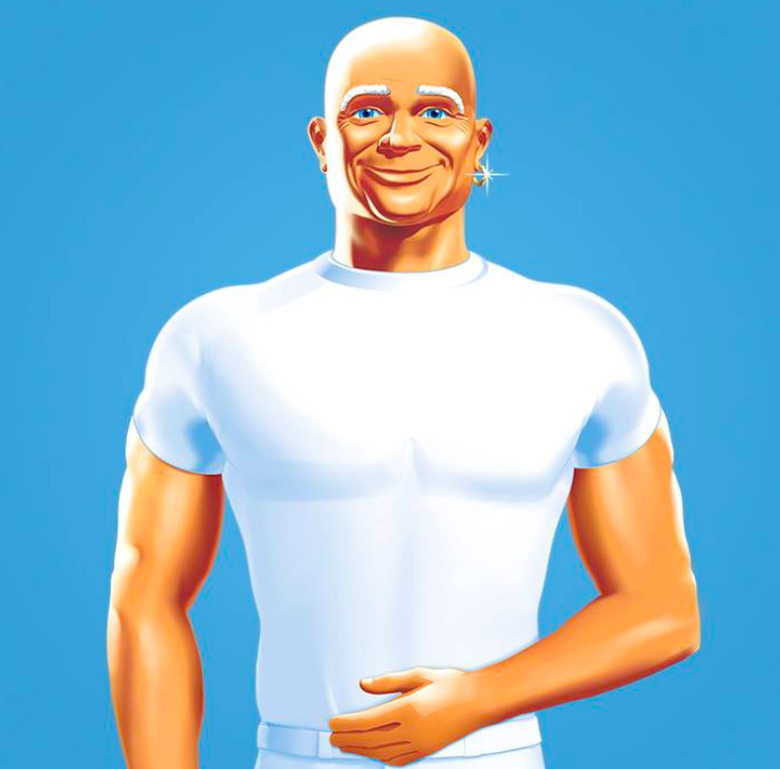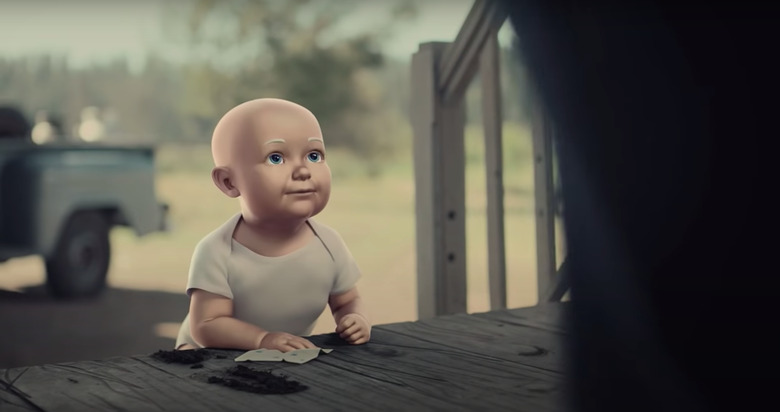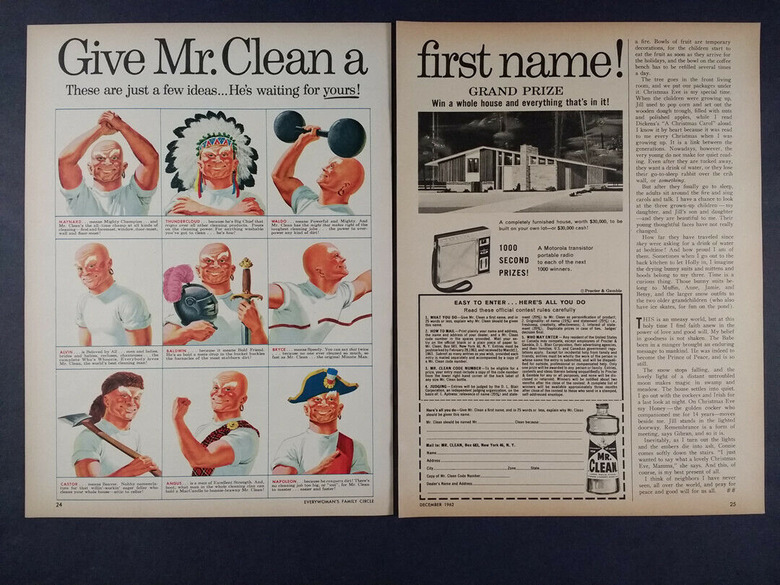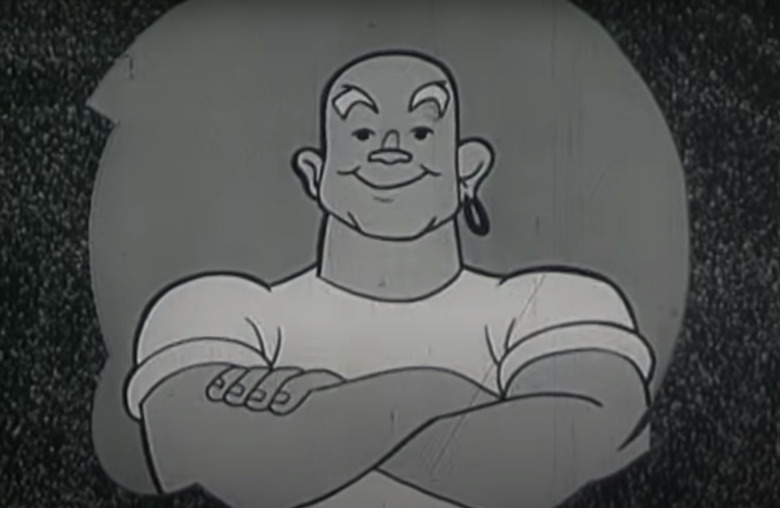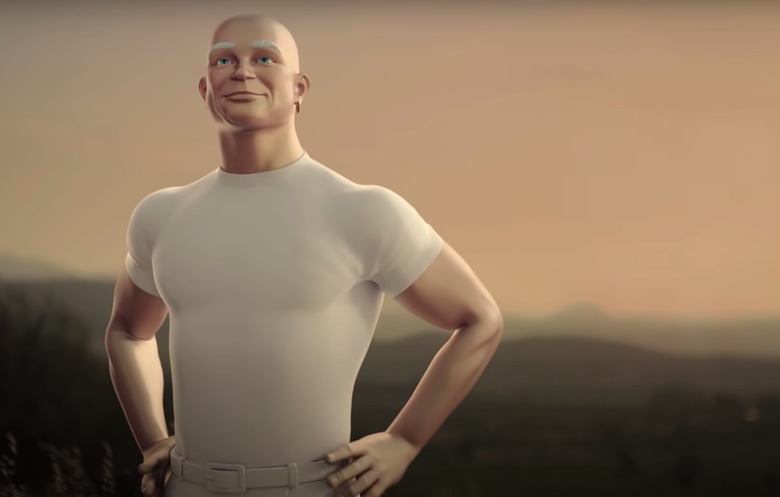13 Facts About Mr. Clean That Range From Fascinating To Weird
Do you really know Mr. Clean? We've all seen the commercials and used his products, but once you start to look into Mr. Clean's history, that's when you'll begin to question everything you thought you knew about the grime-fighting man.
We looked into Mr. Clean's background and compiled some of the weirdest, most interesting facts about the household cleaning mascot. We'll never see him the same way again.
1. A man named Linwood Burton created Mr. Clean for cleaning boats.
1. A man named Linwood Burton created Mr. Clean for cleaning boats.
During the '50s, Linwood Burton owned a company that specialized in cleaning boats, according to Hank Moore's 2016 book Pop Icons and Business Legends. Cleaning boats typically required toxic products, which Burton wasn't a fan of. That's why he designed non-toxic products, which he called "Mr. Clean," for his employees to safely use instead. Burton sold this patent to Procter & Gamble in 1958, according to the U.S. Court of Customs and Patent Appeals.
2. As a baby, the Mr. Clean character was found cleaning a farmer’s front steps.
2. As a baby, the Mr. Clean character was found cleaning a farmer's front steps.
According to the official Mr. Clean website, a farmer discovered baby Mr. Clean when he went out to work his field (ummmm okayyyy??). The "small, sturdy baby, with a remarkably shiny, bald head" was cleaning muddy boot prints off the steps leading up to the farmer's front porch. Despite the fact that this is a strange thing for a baby who looks like an old man to be doing, the farmer and his wife decided to adopt Mr. Clean.
3. Mr. Clean left home to learn everything he could about cleaning — not for himself, but for others.
3. Mr. Clean left home to learn everything he could about cleaning — not for himself, but for others.
Mr. Clean's origin video reveals that he grew up loving to clean messes, not make them. This inspired him to leave home so he could learn everything there is to know about getting rid of grime. Mr. Clean's curiosity led him to college, to cave paintings of people sweeping, to ship docks, to an older woman's kitchen, to the side of a highway, to a diner, and to a mountain overlook where he learned to stand on one foot while holding a heavy bucket in each hand (yes, this is actually a part of the video, but it's also slightly problematic).
4. The Encleanapedia is a mythical book written by Mr. Clean.
4. The Encleanapedia is a mythical book written by Mr. Clean.
The company's official website states that The Encleanapedia is "a chronicle of [Mr. Clean's] adventures and everything he'd learned about cleaning." Procter & Gamble eventually got a hold of this writing (lol), according to the company, and adopted the Mr. Clean brand (which is a unique way of saying that they bought Burton's patent). The Encleanapedia is apparently just the company's history. It has been printed out for use at press events.
5. Mr. Clean made his cartoon debut in 1958.
5. Mr. Clean made his cartoon debut in 1958.
The Cincinnati Business Courier states that after the first Mr. Clean commercial aired on TV in 1958, Mr. Clean became the top U.S. household cleaner within six months. The commercial's jingle, written by Thomas Scott Cadden, was so catchy that the brand ended up revamping it for a 2016 commercial.
6. Vintage Mr. Clean commercials said you could use the product on diamond rings ... and dogs.
6. Vintage Mr. Clean commercials said you could use the product on diamond rings ... and dogs.
In the 1958 Mr. Clean commercial, the jingle includes a line that states: "Can he clean a diamond ring? Mr. Clean cleans anything." The cartoon woman in the video then holds up a dog and a fish bowl, seemingly emphasizing that you can also use Mr. Clean to wash your pup. However, that wasn't the last time that a Mr. Clean commercial suggested you could clean your dog with the product. "He'll even clean the dog himself. No wonder dogs love Mr. Clean!" the narrator states in this '50s Mr. Clean commercial. In the 2016 commercial that revamped that same jingle, both the diamond ring and dog were left out (thank goodness).
6. Mr. Clean may have been modeled after a Navy sailor.
According to marketing agency MLT Creative's character study of Mr. Clean, he was created by Ernie Allen and Harry Barnhart, who worked for Chicago's Tatham-Laird & Kudner advertising agency. They allegedly modeled him after a Navy sailor. In The Advertising Age Encyclopedia of Advertising, authors John McDonough and Karen Egolf state that in 1959, "ad reviewer Andy Armstrong wrote that Mr. Clean fulfilled the dual roles needed to appeal to housewives at the time in that he was both sexy and helpful around the house."
7. Mr. Clean actually has a first name.
7. Mr. Clean actually has a first name.
In 1962, Procter & Gamble launched a contest for people to give Mr. Clean a first name. The grand prize would either be $30,000 in cash or a $30,000 house and everything in it. As for the winning name, the International Business Times reports that it was ... Veritably. According to the Cambridge Dictionary, this word is "used to emphasize the great degree of something." In other words, the name Veritably Clean would mean "a great degree of clean." Smart.
8. There was an actor who portrayed Mr. Clean in a suit.
8. There was an actor who portrayed Mr. Clean in a suit.
In early live-action Mr. Clean commercials, which appeared from the late '50s to early '60s, American actor House Peters Jr. portrayed the grime-fighting man — in a suit, no less! The actor also appeared in shows like Perry Mason and The Twilight Zone.
9. Some people believe Mr. Clean is a genie.
9. Some people believe Mr. Clean is a genie.
The brand's official website states, "Some say he was a genie, others a sailor." The genie comparison comes from the fact that Mr. Clean has a single earring, a bald head, and often appears out of nowhere with his arms crossed. In fact, in the 2014 obituary for Richard Black, the man who illustrated the original Mr. Clean for commercials, The New York Times quoted Procter & Gamble's communications manager, Tricia Higgins, stating that the company initially saw the product as cleaning "like magic." Higgins told the NYT, "Of course magic from a bottle has to be represented by a genie."
Black then produced two sketches of Mr. Clean as a genie — one with a nose ring and one with an earring. The company chose the latter, but the brand comparing him to a genie seems to have stopped (which is probably for the best). In 2014, Mr. Clean responded to a tweet, stating, "I'm no genie, just a man on a mission who also likes to tweet."
10. The European Parliament had a problem with Mr. Clean.
10. The European Parliament had a problem with Mr. Clean.
A September 2008 New York Times article reports that the European Parliament voted to change the way advertisers employ "sexual stereotyping." Mr. Clean was included in this report because his "muscular physique might imply that only a strong man is powerful enough to tackle dirt."
11. Mr. Clean is a gay icon?
11. Mr. Clean is a gay icon?
In a February 2000 Salon piece, the publication referred to Mr. Clean as a "gay icon" because of "[t]he earring, the bulging biceps, the tight white T-shirt, the painted-on pants, the fashionably shaved head, [and] the wry expression." They even asked Mr. Clean spokesperson Damon Jones if the character is gay. "We've been receiving questions like that for at least the past 10 years," Jones responded. "We're not sure where it started — it could have to do with his earring or his attire — but we like to think Mr. Clean was just a man before his time."
12. Mr. Clean embraces sexual innuendos.
12. Mr. Clean embraces sexual innuendos.
For the 2017 Super Bowl, Procter & Gamble released a Mr. Clean commercial that was ... oddly sexual. In the commercial, Mr. Clean can be seen dancing for a woman while cleaning her home. "Mr Clean proves he's got what it takes to satisfy your needs in every room of the house," P&G stated, in reference to the commercial, according to the Cincinnati Business Courier. "Fair warning, things get a little dirty." Anyone else feel uncomfortable?
13. Mr. Clean was a Honda spokesperson and on the cover of a magazine?
13. Mr. Clean was a Honda spokesperson and on the cover of a magazine?
In 1997, Honda used Mr. Clean as a spokesperson for a Honda Accord commercial, according to The Wall Street Journal. But the weird thing is, we can't find that commercial anywhere. Did Procter & Gamble wipe the commercial in an effort to pretend that Mr. Clean never drove a Honda Accord? What's the deal?
According to some reports, Mr. Clean was also on the cover of Biz X Magazine in September 2010, but again, we can't find evidence of that anywhere. The closest we could find is a tiny thumbnail of the magazine on digital publishing platform Blue Toad's website. But when you click on the thumbnail, nothing pops up.
Seems like it's safe to say that Procter & Gamble won't let anything dirty Mr. Clean's image? (Sorry, pun intended.)
